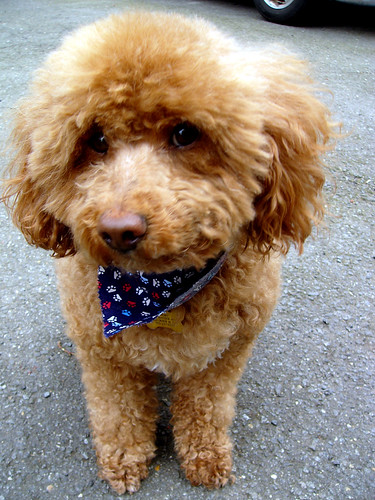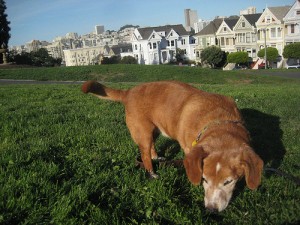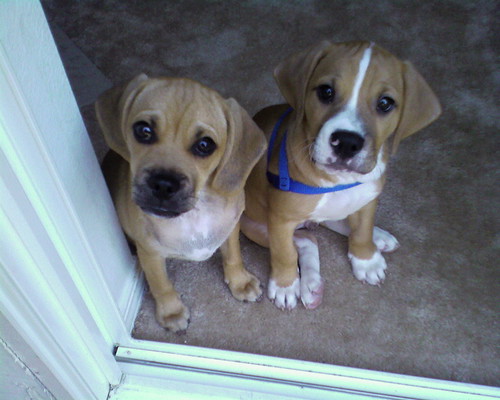You can blame Sirius (the Dog Star, not Black) for these dog days of summer. It’s when this brightest star of Canis Major rises with the sun that our days turn especially hot, hazy, and lazy. And what better way to while away the time than to read some more about our four-legged friends?
Dog is a small word with a multitude of meanings. It comes from the Old English docga, “a powerful kind of dog, a hound,” which may have come from the Proto-Germanic dukkōn, “power, strength, muscle.” In addition to the latrating (or non-latrating) quadruped, dog may refer to “a dull, unattractive girl or woman; a man; a coward; someone who is morally reprehensible; one’s feet.”
The breeds of man’s best friend are even more varied. There are 400 and counting, according to National Geographic, from the tiny chihuahua (named for its city of origin, Chihuahua, Mexico) to the massive mastiff (from the Latin mansuetus, “tame, gentle” and influenced by the Old French mestif, “mongrel”). Dog breeds may be purebred, “that (usually an animal) which has genuine parents of the same breed,” or crossbred, “produced by crossbreeding; bred from different species or varieties.”
Crossbred dogs with unknown parentage are known as mutts, mongrels, curs, and tykes, and while their genetic origins may be obscure, their etymological origins are clear. Mutt is short for muttonhead, and a general term of contempt. Mongrel comes from the Old English gemong, “mingling,” and is related to among. Cur originates from the Swedish dialectal kurre, imitative of a dog’s growl. Tyke comes from the Old Norse tik, or bitch, female dog.
Different regions and countries have their own names for these comingled canines as well. In Hawaii, they’re known as poi dogs (not related to the extinct Hawaiian poi dogs), named for poi, the national food of Hawaiians, and perhaps implying the mixing action of making poi or the mixed heritage of many Hawaiians. In Australia they’re known as bitsa, meaning “bitsa this, bitsa that,” and in the U.S., Heinz 57, named for the “57 varities” slogan of the ketchup company.
On the other hand, designer dogs are hybrids by design rather than chance. The names of these fashionable mutts are usually portmanteaus, or a blend of the names of the parental breeds. For instance, the Labradoodle is both a genetic and linguistic blend between a Labrador retriever and a poodle. But where did those original breed names come from?
Dog breeds are often named for their place of origin, their appearance, or their purpose. The Labrador retriever was once known as the Lesser Newfoundland, and when brought to England was renamed the Labrador, a geographical location near Newfoundland, Canada, to distinguish it from the Newfoundland dog. The word poodle comes from the German pudeln, “to splash about,” which comes from pudel, “puddle,” probably because the poodle was originally bred to hunt and retrieve water fowl.
The cockapoo is a mix between a poodle and a cocker spaniel. The cocker spaniel was so named as it was originally bred to hunt woodcocks, a type of bird, and may have come from Spain (spaniel coming from the Old French espagneul, “Spanish dog”). The springer of springer spaniel (cross that with a Labrador and you get a labradinger) comes from the dog’s springing motion when hunting.
The peekapoo is a cross between a poodle and a Pekingese, which was named for its city of origin, Peking, China, an obsolete name for Beijing. The Schnoodle is a poodle-schnauzer mix, with schnauzer coming from the German Schnauze, “snout,” referring to the dog’s blunt nose. The snorkie is a schnauzer-Yorkshire terrier mix, with Yorkies being named for their place of origin, Yorkshire, England, and terrier coming from the Latin terra, “earth,” as the dogs were originally bred to dig out small prey from the ground.
The baskimo is a cross between the basset hound and American Eskimo dog. Basset of basset hound comes from the French basse, “low,” due to the dog’s short stature. Meanwhile, the American Eskimo dog is neither American nor Eskimo. Originally called the German spitz, it was renamed during World War I due to anti-German sentiment (freedom fries anyone?).
The dorgi is a crossbreed of a dachshund and a corgi. Dachshund comes from the Old German dahs, “badger,” probably because it was originally bred to hunt badgers, while corgi comes from the Welsh cor, “dwarf,” plus ci, “dog.” Supposedly Queen Elizabeth II was the first to introduce the dorgi breed.
The pomchi is a cross between a chihuahua and a Pomeranian, named for Pomerania, a region in Europe and its place of origin. The chug is a a chihuahua-pug mix, while a puggle is a cross between a pug and a beagle (and really freaking cute).
The pug’s etymology is a bit of a mystery. While the breed originated in China, where it was known among other names as the fu, or good luck, dog, how the name pug originated is less clear. Perhaps it came from its pug-nose appearance, in this case pug coming from the Latin pugnus, “fist,” or perhaps due to its mischievous termperment and an alteration of Puck. The beagle’s etymological origin is far more straightforward: it comes from the Old French bee gueule, or loudmouth.
Begging for more? Check out our list of the day, Mix-Breeds, Mutts, and Mongrels by rocksinmypockets, as well as Chained Bear‘s list, Dog Breeds according to Simon & Schuster’s Guide, 1980. In addition, keep your eye out all week for our dog-themed words of the day and lists of the day by following us on Twitter, liking us on Facebook, or subscribing via email.




